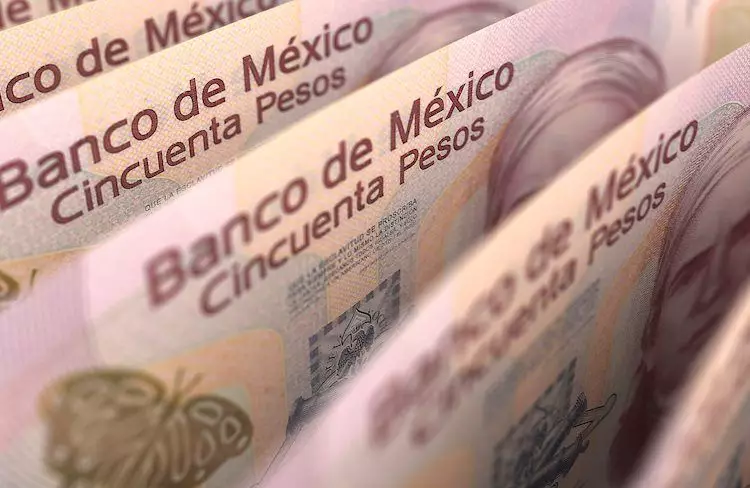In recent weeks, the Mexican Peso (MXN) has experienced a notable surge, reaching levels not seen in three weeks due to a weakening US Dollar (USD). An analysis of economic indicators reveals the underlying dynamics that are propelling this currency shift. The expectations surrounding potential interest rate cuts by the Federal Reserve have put considerable pressure on the USD, while improvements in Mexico’s political landscape, particularly regarding judicial reforms, have eased uncertainty in the Mexican market. These elements combined are fostering optimism about the Peso’s prospects.
As reported by the CME FedWatch Tool, market participants are increasingly anticipating a significant reduction in interest rates, with nearly a 43% chance of a 50 basis point cut. This speculation is not only affecting the sentiment surrounding the dollar but also shaping foreign exchange markets, particularly in relation to the Peso. As traders adjust their forecasts, the correlation between shifts in Fed policy and the strength of the USD against other currencies comes into sharper focus.
Beyond monetary policy, the political atmosphere in Mexico plays a crucial role in the performance of the Peso. The recent approval of judicial reforms has lessened political risks that were previously omnipresent. As a result, confidence in the stability of Mexico’s economy is beginning to reflect positively on the Peso. The interplay between economic health and political stability cannot be overstated; investors invariably seek stable environments, and progress toward reform signals to the markets that Mexico is committed to promoting sound governance.
The upcoming economic reports from Mexico will further clarify the country’s growth trajectory. Key statistics regarding Aggregate Demand and Private Spending for the second quarter of 2024 are set to be released soon, and their reception will undoubtedly influence the Peso’s movement against the USD. With inflation in Mexico dipping below 5% in August, expectations for easing monetary policy by the Bank of Mexico (Banxico) may intensify.
Stepping back to a broader forecast, analysts are speculating that the USD/MXN rates may see continued volatility based on macroeconomic indicators and market sentiment. Current projections suggest that the exchange rate may round out 2024 at approximately 19.50 MXN to the USD and rise slightly to about 19.85 MXN in 2025. These forecasts hinge largely on the trajectory of both Banxico’s policies and the Fed’s response to persistent inflationary pressures in the United States.
The psychological barrier of the 20.00 level in the exchange rate remains a crucial threshold. If the Peso continues to gain momentum, surpassing this level might trigger further bullish sentiment. At present, critical support levels suggest that should the exchange rate slip below the August 23 low of 19.02 MXN, deeper retracements could ensue.
Banxico plays an instrumental role in guiding Mexico’s monetary policy. As the central bank, it targets low and stable inflation rates, aiming for a midpoint of around 3% within a tolerance band of 2% to 4%. Interest rate adjustments serve as a primary tool for Banxico to achieve its inflation objectives. When inflation exceeds set targets, the central bank typically mobilizes to raise rates, making borrowing more expensive and curtailing economic activity. Conversely, a reduction in interest rates is generally perceived as detrimental to the Peso.
The intricacies of monetary policy in Mexico highlight the importance of the rate differential between the USD and MXN. Banxico’s meetings, scheduled eight times a year, are watched closely, especially following Federal Reserve announcements, as the central bank often aims to align its strategies to mitigate potential capital flight and protect the Peso’s value.
The economic health of the United States continues to impact the USD/MXN exchange rate. Notably, the recent rise in the University of Michigan’s Consumer Sentiment index, which jumped from 67.9 to 69.0, suggests a robust outlook among American consumers. This could translate to increased spending and economic momentum south of the border as well. Given that consumer spending is a critical driver of economic growth, shifts in sentiment may resonate through the broader economy.
The interplay of monetary policy changes, political stability, and consumer sentiment contributes to the ever-evolving landscape of the USD/MXN exchange rate. As investors calibrate their expectations concerning Fed actions, the Mexican Peso may continue to rise, but recurring challenges demand vigilance from policymakers and traders alike. As the Mexican economy readies itself for next week’s economic data, the stage is set for continued scrutiny of these key indicators.

